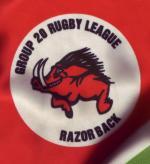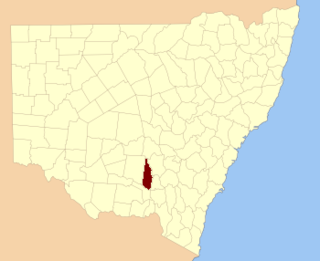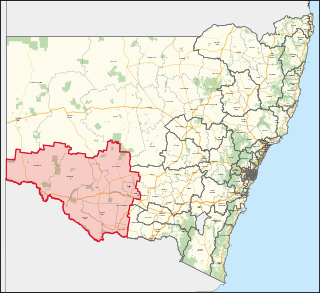
The Riverina is an agricultural region of southwestern New South Wales, Australia. The Riverina is distinguished from other Australian regions by the combination of flat plains, warm to hot climate and an ample supply of water for irrigation. This combination has allowed the Riverina to develop into one of the most productive and agriculturally diverse areas of Australia. Bordered on the south by the state of Victoria and on the east by the Great Dividing Range, the Riverina covers those areas of New South Wales in the Murray and Murrumbidgee drainage zones to their confluence in the west.

Group 9 is a rugby league competition based in Wagga Wagga, New South Wales, Australia, and surrounding areas. The competition is played in six grades, with these being Under 16s, Under 18s, Women's Tackle, Women's League-Tag, Reserve-Grade and First-Grade.

Leeton is a town located in the Riverina region of New South Wales, Australia. It is situated in the Murrumbidgee Irrigation Area. It is the administrative centre of the Leeton Shire Council local government area, which includes neighbouring suburbs, towns and localities such as Yanco, Wamoon, Whitton, Gogeldrie, Stanbridge and Murrami.

Group 20 is a rugby league competition in the region of Griffith, New South Wales, Australia. The competition is played in six grades, with these being Under 16s, Under 18s, Women's League-Tag, Women's Tackle, Reserve Grade and First Grade.

Irrigation Way is a major rural road that runs approximately 85 kilometres (53 mi) through the Murrumbidgee Irrigation Area in south western New South Wales, Australia.

Burrinjuck was an electoral district of the Legislative Assembly in the Australian state of New South Wales from 1950 to 2015.
Lachlan was an electoral district of the Legislative Assembly in the Australian state of New South Wales. During the first two Parliaments (1856–1859), there was an electorate in the same area called Lachlan and Lower Darling, named after the Lachlan and Darling Rivers. Lachlan was created in 1859 and abolished in 1880, partly replaced by Forbes. In 1894 Forbes was abolished and Lachlan was recreated. In 1920 Lachlan and Ashburnham were absorbed into Murrumbidgee and elected three members under proportional representation. At the end of proportional representation in 1927, Lachlan was recreated. It was abolished in 1950, recreated in 1981 and abolished in 2007.

The New South Wales Ministry of Health, branded NSW Health, is a ministerial department of the New South Wales Government. NSW Health supports the executive and statutory roles of the Ministers for Health, Regional Health, Mental Health, and Medical Research. The Ministry also monitors the performance of the state-wide health organisations that collectively make up NSW Health. It is primarily responsible for the public health system in New South Wales, particularly through public hospitals as well as associated agencies and statutory authorities, such as the NSW Ambulance service.

The South Western Slopes, also known as the South West Slopes, is a region predominantly in New South Wales, Australia. It covers the lower inland slopes of the Great Dividing Range, extending from north of Dunedoo through central NSW and into north-east Victoria, meeting its south-western end around Beechworth. More than 90% of the region is in the state of New South Wales and it occupies about 10% of that state – more than 80,000 km2.
Temora was an electoral district for the Legislative Assembly in the Australian State of New South Wales from 1927 to 1981, including the town of Temora.

Cootamundra is an electoral district of the Legislative Assembly in the Australian state of New South Wales.

Bourke County is one of the 141 cadastral divisions of New South Wales. It contains the entirety of the Coolamon Shire, including the towns of Coolamon, Ganmain and Ardlethan; as well as parts of Bland, Narrandera and Temora Shires and part of the City of Wagga Wagga. The Murrumbidgee River is the southern boundary.
Sturt was an electoral district of the Legislative Assembly in the Australian state of New South Wales in the Broken Hill area. It was a single member electorate from 1889 to 1920.
Ashburnham was an electoral district of the Legislative Assembly in the Australian state of New South Wales, originally created in 1894 in the Parkes area and named after Ashburnham County. In 1920, with the introduction of proportional representation, it was absorbed into Murrumbidgee, along with Lachlan. It was recreated in 1927 and abolished in 1950.

Murray is an electoral district in the Australian state of New South Wales.

Ernest Albert Buttenshaw was an Australian politician and member of the New South Wales Legislative Assembly from 1917 until 1932. He was a member of the Nationalist Party of Australia until 1920, when he helped to establish the Progressive Party. After 1925 he was a member of its successor, the Country Party. He was the party leader between 1925 and 1932 and held a number of government ministries.
The South West District Football League was a major Australian rules football competition which ran from 1910 until 1981 in the Riverina region of New South Wales.
This is a list of results for the 2021 New South Wales local elections in the Riverina region.
This is a list of results for the 2024 New South Wales local elections in the Riverina region.
This is a list of results for the 2016 New South Wales local elections in the Riverina region.













